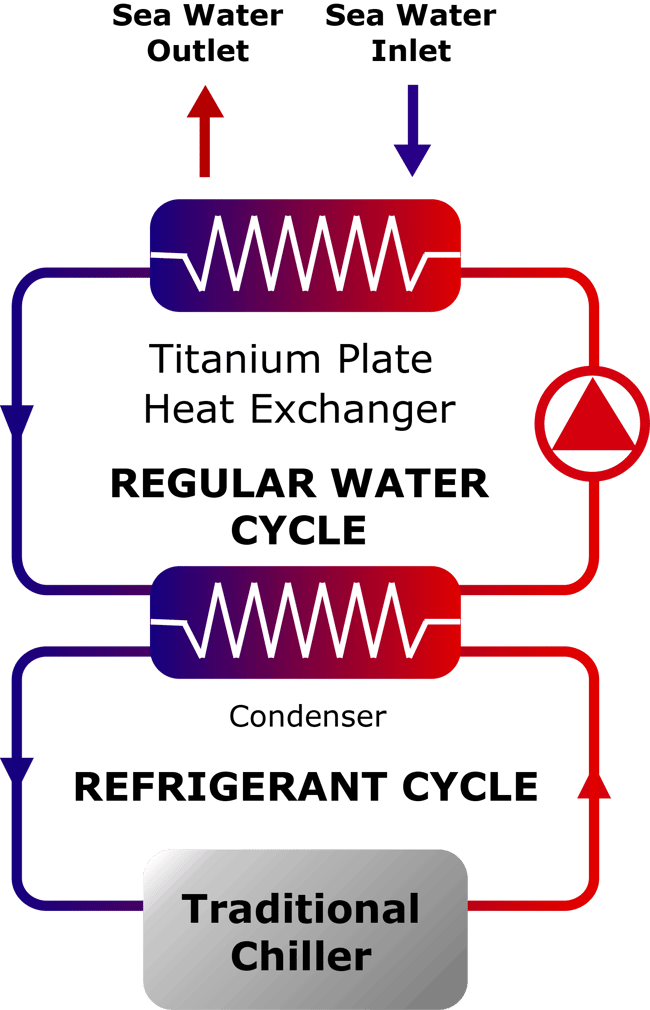Any process that does work or uses energy produces heat, according to thermodynamics principles. We know that many systems release heat to the environment during their operations. This includes the refrigerator in your house. In district cooling plants, the amount of waste heat involved is so enormous that sometimes seas and lakes become the discharge sites for such heat. What happens when you need a heat rejection system for your district cooling system in the middle of the Thar Desert? Are you even able to implement such a project in the area? Geographical location and cost constraints are common challenges when considering installing a district cooling plant. Fortunately, disposing heat into the sea is not the only alternative option. ARANER can design and size a variety of heat rejection methods to suit your system requirements even in the middle of a desert. Below is a discussion about the most common heat rejection condensing technologies today.
1. Seawater Cooled Condenser
For systems located near the sea, using the vast amount of water to reject heat is viable and cost effective option. Apart from energy savings, the method is also eco-friendly. However, the inevitable need to design this technology for the harsh sea conditions means that initial cost implication can be a challenge. Suitable materials for the high corrosive environment, such as titanium, are needed increasing the total cost of the project. However, ARANER has developed very cost-effective solution for sea water cooled chillers. The good thing is that the enormous savings in energy can help you recoup the initial cost within a few years.

Fig 1: Standard sea water condensation scheme. (For optimized sea water condensation with direct condensation contact ARANER).
2. Air Cooled Condenser
Does the development of district cooling in the arid regions such as the Middle East fascinate you? How do they cool their systems? Thanks to advances in technology, district cooling plants are able to cool just using ambient air. This happens in the presence of a heat exchanger and several air fans that enhance air circulation. For its zero use of water, this technology has found immense applications in areas of water scarcity, for example the Middle East. It is also popular for places where tough environmental legislation limits water use. With ARANER’s heat rejection systems, you will not only bypass the need for water, but also use less energy thanks to energy efficient equipment. Customers using this technology also enjoy the following advantages:
- No discharge of heat into the sea
- Reduced environmental degradation
- The system is low maintenance
3. Water Cooled Condenser
This popular method is highly related to cooling towers. This technology requires two steps to complete heat transfer. In the first step, the condenser water takes heat from the refrigerant. Then the water goes to the cooling tower where it eliminates heat to the atmosphere. This process can also be optimized with one single step with direct condensation. Regarding types of this technology, power plants and other large water flow applications prefer natural draft cooling towers. Provided you have enough space to accommodate the huge structure and money for installation, you can have this tower installed in your facility. Its benefits include minimal noise emission and energy savings. Other cooling tower types to consider are:
- Mechanical draft cooling towers
- Fiberglass cooling towers
- Concrete cooling towers
- Hybrid cooling towers
Generally, water-cooled condensers require high initial investment in terms of equipments, piping and pumps. Coupling this with water conservation and cost issues can make air-cooling preferable in some instances.
4. Geothermy Condenser
Geothermal heat rejection system (many times linked with geothermal heat pump systems) applies the heat absorption capability of the earth. This technology is mostly popular in the colder climates, particularly in Europe. Its higher efficiency in such environments is the main selling point. Other advantages include low maintenance needs, minimal effect on environment and high reliability. Like the other heat rejection condensing technologies, geothermy has several disadvantages. For instance, an error in design can cause coldness to accumulate and affect system effectiveness. Usually, such systems do not sustain their performance for more than a decade. If your space is inadequate, you may not be in a position to install this heat rejection solution. Ground heat exchangers need ample amount of land to be effective. It is almost impossible to use geothermy solely for cooling in areas outside the cold climates. This is because the cooling system COP tends to drop as the ground temperature increases with time. However, the system tends to have sustained performance if the system is for both cooling and heating (heat pump). There you have it. We have outlined the most common heat rejection condensing technologies globally. Each has its pros and cons, and application depends on different factors, mostly environmental. You can contact ARANER for a consultative design of your heat rejection condensing solution.










